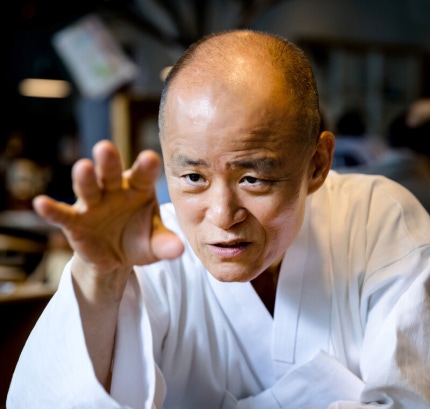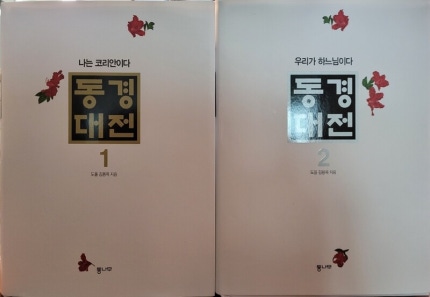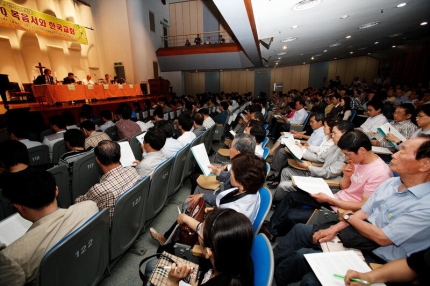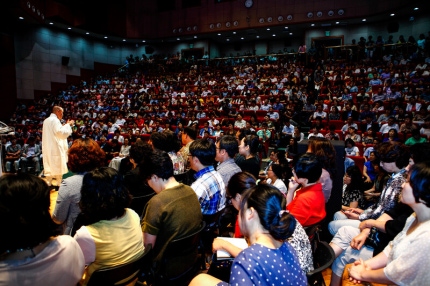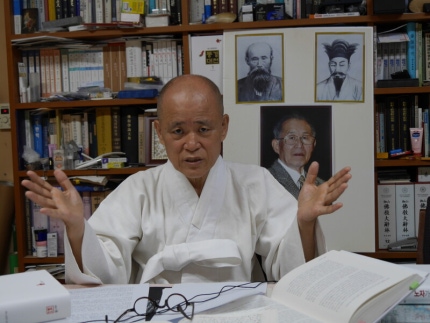Bart D. Ehrman
Bart D. Ehrman | |
|---|---|
 Ehrman in 2012, Photo by M. Caravaggio | |
| Born | Bart Denton Ehrman October 5, 1955 Lawrence, Kansas, U.S. |
| Nationality | American |
| Education | |
| Employer | The Department of Religious Studies, University of North Carolina at Chapel Hill. |
| Known for |
|
Notable work |
|
| Title | James A. Gray Distinguished Professor of Religious Studies |
| Website | bartdehrman.com |
Bart Denton Ehrman (/bɑːrt ˈɜːrmən/; born October 5, 1955) is an American New Testament scholar focusing on textual criticism of the New Testament, the historical Jesus, and the origins and development of early Christianity. He has written and edited 30 books, including three college textbooks. He has also authored six New York Times bestsellers. He is currently the James A. Gray Distinguished Professor of Religious Studies at the University of North Carolina at Chapel Hill.
Early life[edit source]
Ehrman grew up in Lawrence, Kansas, and attended Lawrence High School, where he was on the state champion debate team in 1973. He began studying the Bible, Biblical theology and Biblical languages at Moody Bible Institute,[1] where he earned the school's three-year diploma in 1976.[2] He is a 1978 graduate of Wheaton College in Illinois, where he received his bachelor's degree. He received his Ph.D. (in 1985) and M.Div. from Princeton Theological Seminary, where he studied textual criticism of the Bible, development of the New Testament canon and New Testament apocrypha under Bruce Metzger. Both baccalaureate and doctorate were conferred magna cum laude.[3]
Career[edit source]
Ehrman was raised in an Anglican family and was originally a member of the Episcopal Church of the United States; as a teenager, he became a born-again Evangelical.[1][4][5] In Misquoting Jesus, he recounts being certain in his youthful enthusiasm that God had inspired the wording of the Bible and protected its texts from all error.[1][4] His desire to understand the original words of the Bible led him to the study of ancient languages, particularly Koine Greek, and to textual criticism. During his graduate studies, however, he became convinced that there are contradictions and discrepancies in the biblical manuscripts that could not be harmonized or reconciled:[1]
He remained a liberal Christian for 15 years, but later became an agnostic atheist after struggling with the philosophical problems of evil and suffering.[1][2][6]
Ehrman has taught at the University of North Carolina at Chapel Hill since 1988, after four years of teaching at Rutgers University. At UNC he has served as both the Director of Graduate Studies and the Chair of the Department of Religious Studies. He was the recipient of the 2009 J. W. Pope "Spirit of Inquiry" Teaching Award, the 1993 UNC Undergraduate Student Teaching Award, the 1994 Phillip and Ruth Hettleman Prize for Artistic and Scholarly Achievement, and the Bowman and Gordon Gray Award for excellence in teaching.
Ehrman currently serves as co-editor of the series New Testament Tools, Studies, and Documents (E. J. Brill), co-editor-in-chief for the journal Vigiliae Christianae, and on several other editorial boards for journals and monographs. Ehrman formerly served as President of the Southeast Region of the Society of Biblical Literature, chair of the New Testament textual criticism section of the Society, book review editor of the Journal of Biblical Literature, and editor of the monograph series The New Testament in the Greek Fathers (Scholars Press).
Ehrman speaks extensively throughout the United States and has participated in many public debates, including debates with William Lane Craig,[7] Dinesh D'Souza,[8] Mike Licona,[9] Craig A. Evans,[10] Daniel B. Wallace,[11] Richard Swinburne,[12] Peter J. Williams,[13] James White,[14] Darrell Bock,[15] Michael L. Brown,[16] and Robert M. Price.[17]
In 2006 he appeared on The Colbert Report[18] and The Daily Show,[19] to promote his book Misquoting Jesus, and in 2009 reappeared on The Colbert Report[20] with the release of Jesus, Interrupted. Ehrman has appeared on the History Channel, the National Geographic Channel, Discovery Channel, A&E, Dateline NBC, CNN, and NPR's Fresh Air and his writings have been featured in Time, Newsweek, The New York Times, The New Yorker, and The Washington Post.
Works[edit source]
Ehrman has written widely on issues of the New Testament and early Christianity at both an academic and popular level, much of it based on textual criticism of the New Testament. His thirty books include three college textbooks and six New York Times bestsellers: Misquoting Jesus,[21] Jesus, Interrupted,[22] God's Problem,[23] Forged,[24][25] How Jesus Became God,[26] and The Triumph of Christianity.[27] More than two million copies of his books have been sold, and his books have been translated into 27 languages.[28]
In The Orthodox Corruption of Scripture, Ehrman argues that there was a close relationship between the social history of early Christianity and the textual tradition of the emerging New Testament. He examines how early struggles between Christian "heresy" and "orthodoxy" affected the transmission of the documents. Ehrman is often considered a pioneer in connecting the history of the early church to textual variants within biblical manuscripts and in coining such terms as "proto-orthodox Christianity".[29]
In Jesus: Apocalyptic Prophet of the New Millennium, Ehrman agrees with Albert Schweitzer's thesis that Jesus was a Jewish apocalyptic preacher and that his main message was that the end times was near, that God would shortly intervene to overthrow evil and establish his rule on Earth, and that Jesus and his disciples all believed these end time events would occur in their lifetimes.[30]
In Truth and Fiction in The Da Vinci Code, Ehrman expands on his list of ten historical and factual inaccuracies in Dan Brown's novel, previously incorporated in Dan Burstein's Secrets of the Code.[31]
In Misquoting Jesus, Ehrman introduces New Testament textual criticism. He outlines the development of New Testament manuscripts and the process and cause of manuscript errors in the New Testament.[32][33]
In Jesus, Interrupted, 예수 왜곡의 역사 he describes the progress scholars have made in understanding the Bible over the past two hundred years and the results of their study, results which are often unknown among the population at large. In doing so, he highlights the diversity of views found in the New Testament, the existence of forged books in the New Testament which were written in the names of the apostles by Christian writers who lived decades later, and his belief that Christian doctrines such as the suffering Messiah, the divinity of Jesus, and the Trinity were later inventions.[34][35] Though, he has changed his mind on several issues, most notably, the divinity of Jesus in the Synoptic Gospels.[36][37]
In Forged, Ehrman posits some New Testament books are literary forgeries and shows how widely forgery was practiced by early Christian writers—and how it was condemned in the ancient world as fraudulent and illicit.[38] His scholarly book, Forgery and Counterforgery, is an advanced look at the practice of forgery in the NT and early Christian literature. It makes a case for considering falsely attributed or pseudepigraphic books in the New Testament and early Christian literature "forgery", looks at why certain New Testament and early Christian works are considered forged, and describes the broader phenomenon of pseudepigraphy in the Greco-Roman world.[39]
In 2012, Ehrman published Did Jesus Exist? The Historical Argument for Jesus of Nazareth, defending the historical existence of Jesus of Nazareth in contrast to the mythicist theory that Jesus is an entirely fictitious being.[40]
The 2014 release of How Jesus Became God: The Exaltation of a Jewish Preacher from Galilee 예수는 어떻게 신이 되었나 examines the historical Jesus, who according to Ehrman neither thought of himself as God nor claimed to be God, and proffers how he came to be thought of as the incarnation of God himself.[41]
In Jesus Before the Gospels, he examines the early Christian oral tradition and its role in shaping the stories about Jesus that we encounter in the New Testament.[42]
In The Triumph of Christianity: How a Forbidden Religion Swept the World, he notes that from the diversity of Christianity "throughout the first four Christian centuries", eventually only one form of Christianity, Nicene Christianity, became dominant under the rule of the Roman Emperor Constantine and his successors.[43]
In Heaven and Hell: A History of the Afterlife, he examines the historical development of the concepts of the afterlife throughout Greek, Jewish, and early Christian cultures, and how they eventually converged into the modern concepts of Heaven and Hell that modern Christians believe in.
Reception[edit source]
Ehrman has been the recipient of the 2009 J. W. Pope "Spirit of Inquiry" Teaching Award, the 1993 UNC Undergraduate Student Teaching Award, the 1994 Phillip and Ruth Hettleman Prize for Artistic and Scholarly Achievement, and the Bowman and Gordon Gray Award for excellence in teaching.[3]
Daniel Wallace has praised Ehrman as "one of North America's leading textual critics" and describes him as "one of the most brilliant and creative textual critics I have ever known". Wallace argues, however, that in Misquoting Jesus Ehrman sometimes "overstates his case by assuming that his view is certainly correct." For example, Wallace asserts that Ehrman himself acknowledges the vast majority of textual variants are minor, but his popular writing and speaking sometimes makes the sheer number of them appear to be a major problem for getting to the original New Testament text.[44]
Ehrman's The New Testament: A Historical Introduction to the Early Christian Writings is widely used at American colleges and universities.[45][46] The textbook holds to a traditional interpretation of the Gospel of Thomas in the context of second-century Christian Gnosticism, a view that has been criticized by Elaine Pagels.[47]
Andreas J. Köstenberger, Darrell L. Bock and Josh D. Chatraw have disputed Ehrman's depiction of scholarly consensus, saying: "It is only by defining scholarship on his own terms and by excluding scholars who disagree with him that Ehrman is able to imply that he is supported by all other scholarship."[48] Michael R. Licona, notes, however, that "his thinking is hardly original, as his positions are those largely embraced by mainstream skeptical scholarship".[46]
Gary Kamiya states in Salon that "Ehrman's scholarly standing did not soothe the evangelical Christians who were outraged by Misquoting Jesus. Angered by what they took to be the book's subversive import, they attacked it as exaggerated, unfair and lacking a devotional tone. No fewer than three books were published in response to Ehrman's tome".[49] In 2014, Zondervan published How God Became Jesus: The Real Origins of Belief in Jesus' Divine Nature: A Response to Bart D. Ehrman as a planned companion volume to Ehrman's How Jesus Became God. The contributing authors—including Michael F. Bird, Craig A. Evans, and Simon Gathercole—present Ehrman as "prone to profound confusion, botched readings and scholarly fictions."[50] Bird writes, "For conservative Christians, Ehrman is a bit of a bogeyman, the Prof. Moriarty of biblical studies, constantly pressing an attack on their long-held beliefs about God, Jesus, and the Bible.... For secularists, the emerging generation of 'nones' (who claim no religion, even if they are not committed to atheism or agnosticism), Ehrman is a godsend."[51]
Speaking to CNN, Rev. Guy Williams, a Methodist minister in Houston, said of Ehrman: "His take on the scriptures is a gift to the church because of his ability to articulate questions and challenges. It gives us an opportunity to wrestle with the [Bible's] claims and questions."[52]
Bibliography[edit source]
- Didymus the Blind and the Text of the Gospels (The New Testament in the Greek Fathers; No. 1). Society of Biblical Literature. 1987. ISBN 1-55540-084-1.
- The Text of the Fourth Gospel in the Writings of Origen (The New Testament in the Greek Fathers; vol. 1). Society of Biblical Literature. 1992. ISBN 1555407897.
- The Orthodox Corruption of Scripture: The Effect of Early Christological Controversies on the Text of the New Testament. Oxford University Press, US. 2011 [1996]. ISBN 978-0-19-973978-3.
- The Text of the New Testament in Contemporary Research: Essays on the Status Quaestionis. Wm. B. Eerdmans Publishing Company. 1995. ISBN 0-8028-4824-9.
- The New Testament: A Historical Introduction to the Early Christian Writings. Oxford University Press, US. 1997. ISBN 0-19-515462-2.
- The New Testament and Other Early Christian Writings: A Reader. Oxford University Press, US. 1998. ISBN 0-19-515464-9.
- After the New Testament: A Reader in Early Christianity. Oxford University Press, US. 1998. ISBN 0-19-511445-0.
- Jesus: Apocalyptic Prophet of the New Millennium. Oxford University Press, US. 1999. ISBN 0-19-512474-X.
- The Apostolic Fathers: Volume I. I Clement. II Clement. Ignatius. Polycarp. Didache. Harvard University Press. 2003. ISBN 0-674-99607-0.
- The Apostolic Fathers: Volume II. Epistle of Barnabas. Papias and Quadratus. Epistle to Diognetus. The Shepherd of Hermas. Harvard University Press. 2003. ISBN 0-674-99608-9.
- Lost Scriptures: Books that Did Not Make It into the New Testament. Oxford University Press, US. 2003. ISBN 0-19-514182-2.
- Lost Christianities: The Battles for Scripture and the Faiths We Never Knew. Oxford University Press, US. 2003. ISBN 0-19-514183-0.
- Ehrman, Bart; Jacobs, Andrew S. (2003). Christianity in Late Antiquity, 300–450 C.E.: A Reader. Oxford University Press, US. ISBN 0-19-515461-4.
- A Brief Introduction to the New Testament. Oxford University Press, US. 2004. ISBN 0-19-516123-8.
- Truth and Fiction in The Da Vinci Code: A Historian Reveals What We Really Know about Jesus, Mary Magdalene, and Constantine. Oxford University Press, US. 2004. ISBN 0-19-518140-9.
- Metzger, Bruce M.; Ehrman, Bart (2005). The Text of the New Testament: Its Transmission, Corruption, and Restoration. Oxford University Press, US. ISBN 0-19-516667-1.
- Misquoting Jesus: The Story Behind Who Changed the Bible and Why. HarperSanFrancisco. 2005. ISBN 0-06-073817-0.
- Peter, Paul, and Mary Magdalene: The Followers of Jesus in History and Legend. Oxford University Press, US. 2006. ISBN 0-19-530013-0.
- Studies in the Textual Criticism of the New Testament. Brill Publishers, US. 2006. ISBN 90-04-15032-3.
- The Lost Gospel of Judas Iscariot: A New Look at Betrayer and Betrayed. Oxford University Press, US. 2006. ISBN 978-0-19-531460-1.
- God's Problem: How the Bible Fails to Answer Our Most Important Question – Why We Suffer. HarperCollins, US. 2008. ISBN 978-0-06-117397-4.
- Jesus, Interrupted: Revealing the Hidden Contradictions in the Bible (And Why We Don't Know About Them). HarperCollins, US. 2009. ISBN 978-0-06-117394-3.
- Forged: Writing in the Name of God – Why the Bible's Authors Are Not Who We Think They Are. HarperCollins, US. 2011. ISBN 978-0-06-201261-6.
- Ehrman, Bart; Pleše, Zlatko (2011). The Apocryphal Gospels: Texts and Translations. Oxford University Press, US. ISBN 978-0-19-973210-4.
- Did Jesus Exist? The Historical Argument for Jesus of Nazareth. HarperCollins, US. 2012. ISBN 978-0-06-220460-8.
- Forgery and Counterforgery: The Use of Literary Deceit in Early Christian Polemics. Oxford University Press, US. 2012. ISBN 978-0-19-992803-3.
- The Bible: A Historical and Literary Introduction. Oxford University Press, US. 2013. ISBN 978-0-19-530816-7.
- The Other Gospels: Accounts of Jesus from Outside the New Testament. Oxford University Press, US. 2013. ISBN 978-0-19-933522-0.
- How Jesus Became God: The Exaltation of a Jewish Preacher from Galilee. HarperOne, US. 2014. ISBN 978-0-06-177818-6.
- Jesus Before the Gospels: How the Earliest Christians Remembered, Changed, and Invented Their Stories of the Savior. HarperOne, US. 2016. ISBN 978-0062285201.
- The Triumph of Christianity: How a Forbidden Religion Swept the World. Simon & Schuster, US. 2018. ISBN 978-1501136702.
- Heaven and Hell: A History of the Afterlife. Simon & Schuster, US. 2020. ISBN 978-1501136733.
References[edit source]
- ^ a b c d e f Kinlaw, Robert; Stasio, Frank (March 5, 2018). "The Sunday School Teacher Turned Skeptic: Meet Bart Ehrman". WUNC News. Chapel Hill, North Carolina. Retrieved February 5, 2020.
- ^ a b Ehrman, Bart D. Misquoting Jesus, HarperSanFrancisco. 2005. ISBN 0-06-073817-0
- ^ a b "Bart D Ehrman - Biography". Bart D Ehrman. 2017. Retrieved January 26, 2017.
- ^ a b Shanks, Hershel, ed. (April 2007). "Losing Faith: Who Did and Who Didn't - How Scholarship Affects Scholars". Biblical Archaeology Review. Biblical Archaeology Society. 33 (2). Retrieved February 5, 2020.
- ^ "Denver Seminary > Articles > Misquoting Jesus: The Story Behind Who Changed the Bible and Why". web.archive.org. April 25, 2009. Retrieved June 20, 2021.
- ^ "Bart Erhman - Freedom From Religion Foundation".
- ^ "Ehrman vs Craig: Evidence for Resurrection". YouTube. March 28, 2006.
- ^ "Theodicy, God & Suffering - Ehrman vs D'Souza". YouTube. November 11, 2010.
- ^ "Bart Ehrman vs. Mike Licona 2009 Debate". YouTube. April 2, 2009.
- ^ "Bart Ehrman & Craig Evans 2012 Debate P1". YouTube. January 19, 2012.
- ^ "Bart Ehrman & Daniel Wallace Debate Original NT Lost?". YouTube. February 1, 2012.
- ^ "God's Problem - Bart vs. Richard G. Swinburne". YouTube. January 10, 2009.
- ^ "Misquoting Jesus - Bart D. Ehrman vs Peter J. Williams". YouTube. January 3, 2009.
- ^ "Bart Ehrman vs. James White Debate P1". YouTube. January 21, 2009.
- ^ "Was the New Testament Forged Bart Ehrman vs Darrell Bock". YouTube. August 21, 2011.
- ^ "Bart Ehrman vs. Michael Brown on Suffering". YouTube. April 15, 2010.
- ^ "Bart Ehrman & Robert Price Debate - Did Jesus Exist". YouTube. October 21, 2016.
- ^ "Bart Ehrman". CC.com. The Colbert Report. June 20, 2006. Retrieved July 13, 2019.
- ^ "Bart Ehrman". CC.com. The Daily Show. March 14, 2006. Retrieved July 13, 2019.
- ^ "Bart Ehrman". CC.com. The Colbert Report. April 9, 2009. Retrieved July 13, 2019.
- ^ Dwight Garner (April 2, 2006). "Inside the List: The Agnostic". The New York Times. Retrieved October 22, 2013.
- ^ Jennifer Schuessler (March 19, 2009). "Inside the List: Honest to Jesus". The New York Times. Retrieved October 22,2013.
- ^ "Best Sellers: Hardcover Nonfiction (March 9, 2008)". The New York Times. March 9, 2008. Retrieved October 22, 2013.
- ^ "Best Sellers: Hardcover Nonfiction: Sunday, April 10th 2011". The New York Times. April 10, 2011. Retrieved October 22, 2013.
- ^ "Bart D Ehrman Professional Website".
- ^ Cowles, Gregory (April 13, 2014). "Best Sellers: Hardcover Nonfiction (April 13, 2014)". The New York Times. Retrieved July 17, 2014.
- ^ "Best Sellers: Hardcover Nonfiction (April 8, 2018)". The New York Times. April 8, 2018. Retrieved April 7, 2018.
- ^ "Bart D. Ehrman (Fellow)". John Simon Guggenheim Memorial Foundation. 2018. Retrieved April 7, 2018.
- ^ Collins, Raymond F. "The Orthodox Corruption of Scripture". Journal of Early Christian Studies.
- ^ Ehrman, Bart D. (1999). Jesus: Apocalyptic Prophet of the New Millennium. New York: Oxford University Press. p. 3. ISBN 0195124731.
- ^ Truth and Fiction in The Da Vinci Code: A Historian Reveals What We Really Know about Jesus, Mary Magdalene, and Constantine. Oxford University Press. p. xiii.
- ^ Garner, Dwight (April 2, 2006). "Inside the List". New York Times. Retrieved May 24, 2014.
- ^ Gross, Terry. "Bart Ehrman's 'Misquoting Jesus'". NPR. Retrieved May 24, 2014.
- ^ Barlow, Rich (May 6, 2009). "Book review: Turning a critical eye to the Bible". Boston Globe. Retrieved October 1,2010.
- ^ Blake, John (May 15, 2009). "Former fundamentalist 'debunks' Bible". CNN. Retrieved May 24, 2014.
- ^ https://ehrmanblog.org/jesus-as-divine-in-the-synoptics-for-members/
- ^ https://ehrmanblog.org/jesus-as-god-in-the-synoptics-for-members/
- ^ "Half of New Testament forged, Bible scholar says". CNN. May 13, 2011. Retrieved May 17, 2011. CNN book review article summarizing Ehrman's claim that much of the New Testament was written as a forgery.
- ^ "Forgery and Counterforgery. The Use of Literary Deceit in Early Christian Polemics". Oxford University Press. Retrieved May 24, 2014.
- ^ Ehrman, Bart D. (March 20, 2013). "Did Jesus Exist?". huffingtonpost.com. The Huffington Post. Archived from the original on July 3, 2016. Retrieved April 8, 2014.
- ^ "How Jesus Became God". NPR.com. NPR. Retrieved July 14, 2014.
- ^ Ehrman, Bart D. "Jesus Before the Gospels - Bart D. Ehrman - Hardcover". HarperCollins US. Retrieved October 30,2016.
- ^ Ehrman, Bart D. (2018). The Triumph of Christianity: How a Forbidden Religion Swept the World. Simon & Schuster. pp. 128, 309, n. 39. ISBN 978-1-5011-3672-6.
Christianity was an amazingly diverse phenomenon throughout the first four Christian centuries, with different Christians advocating an enormous range of beliefs and engaging in strikingly different practices. This has been the subject of a large number of books in modern times, especially over the past forty years.
- ^ Daniel B. Wallace, "The Gospel According to Bart: A Review Article of Misquoting Jesus by Bart Ehrman," Journal of the Evangelical Theological Society 49/2 (June 2006) 327–49.
- ^ Kirk, Alan (December 1, 2010). Holmén, Tom; Porter, Stanley E. (eds.). Handbook for the Study of the Historical Jesus (4 Vols). BRILL. p. 822. ISBN 978-90-04-16372-0.
- ^ a b Licona, Michael (March 1, 2012). Copan, Paul; Lane Craig, William (eds.). Come Let Us Reason: New Essays in Christian Apologetics. B&H Publishing Group. p. 137. ISBN 978-1-4336-7599-7.
- ^ Elaine Pagels 2015 (lecture). "Price Lecture: Elaine Pagels" on YouTube (15:42~15:55) Trinity Church Boston. Accessed August 30, 2016.
- ^ Köstenberger, Andreas J.; Bock, Darrell L.; Chatraw, Josh D. (2014). Truth in a Culture of Doubt: Engaging Skeptical Challenges to the Bible. B&H Publishing Group. p. 34. ISBN 9781433684043. Retrieved October 30, 2015.
- ^ Kamiya, Gary. "Jesus is just alright with him". Salon. Retrieved September 3, 2016.
- ^ Murawski, John (March 25, 2014). "Bart Ehrman's 'How Jesus Became God' Book Will Be Instantly Rebutted By 'How God Became Jesus'". Huffington Post. Religion News Service. Retrieved September 3, 2016.
- ^ Bird, Michael F.; Evans, Craig A.; Gathercole, Simon; Hill, Charles E.; Tilling, Chris (2014). Bird, Michael F. (ed.). How God Became Jesus: The Real Origins of Belief in Jesus' Divine Nature — A Response to Bart Ehrman. Zondervan. pp. 7–8. ISBN 978-0-310-51961-4. Preview (arrow-searchable).
- ^ Blake, John (May 15, 2009). "Former fundamentalist 'debunks' Bible". CNN. Retrieved August 30, 2016.
Further reading[edit source]
- Price, Robert M. (2018), Bart Ehrman Interpreted: How One Radical New Testament Scholar Understands Another, Durham, NC: Pitchstone Publishing (US&CA), ISBN 9781634311588, OCLC 1020301095
External links[edit source]
| Wikiquote has quotations related to: Bart D. Ehrman |
- Official website

- "Ehrman's blog".
Christianity in Antiquity (CIA)
- "Bart D. Ehrman". Faculty. Chapel Hill: University of North Carolina.
- "Bart D. Ehrman". The Teaching Company.
- "A Few Questions for Bart Ehrman". Academic Insights for the Thinking World. Oxford University Press. October 9, 2006.
- Kinlaw, Robert; Stasio, Frank (March 5, 2018). "The Sunday School Teacher Turned Skeptic: Meet Bart Ehrman" (pod). State of Things. WUNC (NPR).

